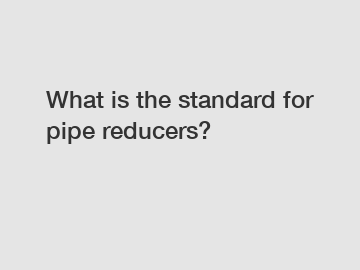Jan. 20, 2024
Mechanical Parts
What is the Standard for Pipe Reducers?
A pipe reducer is a fitting that is used to connect pipes of different sizes together. It is commonly used in piping systems to reduce the size of a pipe, allowing for a smooth flow of fluids or gases. The standard for pipe reducers is determined by various industry organizations, such as the American Society of Mechanical Engineers (ASME) and the International Organization for Standardization (ISO).
The standard for pipe reducers primarily focuses on the dimensions, materials, and testing requirements. The dimensions of a pipe reducer are crucial to ensure compatibility and proper fitment within the piping system. The standard specifies the nominal sizes, outside diameter, wall thickness, and length of the reducer. These dimensions are standardized to ensure interchangeability between different manufacturers and prevent any issues during installation.

The materials used for pipe reducers are also determined by the standard. Commonly used materials include carbon steel, stainless steel, cast iron, and PVC (polyvinyl chloride). The choice of material depends on the specific application, such as the temperature, pressure, and the type of fluid or gas being conveyed. The standard specifies the material requirements, including the chemical composition, mechanical properties, and heat treatment, to ensure the reducer's strength and durability.
In addition to dimensions and materials, the standard for pipe reducers also outlines the testing requirements. This includes various tests to verify the quality and performance of the reducers. Some of the commonly conducted tests include dimensional inspection, visual inspection, mechanical testing (such as tensile and hardness testing), and leak testing. These tests are essential to ensure that the pipe reducers meet the required specifications and perform reliably under operating conditions.
The implementation of a standard for pipe reducers brings several benefits and impacts the industry. Firstly, it ensures uniformity and compatibility between different manufacturers. This allows for the easy procurement and interchangeability of pipe reducers, reducing the chances of delays or errors during installation. Secondly, the standard ensures the quality and reliability of pipe reducers by defining the requirements and testing procedures. This helps to prevent any failures or leaks, which could lead to costly repairs or accidents. Lastly, adherence to the standard promotes efficiency in the industry as it provides a common guideline for engineers, designers, and manufacturers, facilitating streamlined processes and better communication.
In conclusion, the standard for pipe reducers is vital in ensuring the compatibility, quality, and performance of these fittings in various piping systems. The standard, established by organizations like ASME and ISO, specifies dimensions, materials, and testing requirements. Adhering to this standard brings numerous benefits, including easy interchangeability, enhanced reliability, and improved industry efficiency. By following the standard, engineers, designers, and manufacturers can confidently select, install, and rely on pipe reducers for efficient fluid or gas flow in a multitude of applications.
If you are looking for more details, kindly visit stainless steel forged weld neck flange, steel pipe reducer, fusion pipe company.
Previous: 10 best European Swivel Eye And Eye Casting options for B2B purchase decision?
Next: Boost Efficiency & Safety with Camlock Connectors - The Ultimate Guide!
If you are interested in sending in a Guest Blogger Submission,welcome to write for us!
All Comments ( 0 )